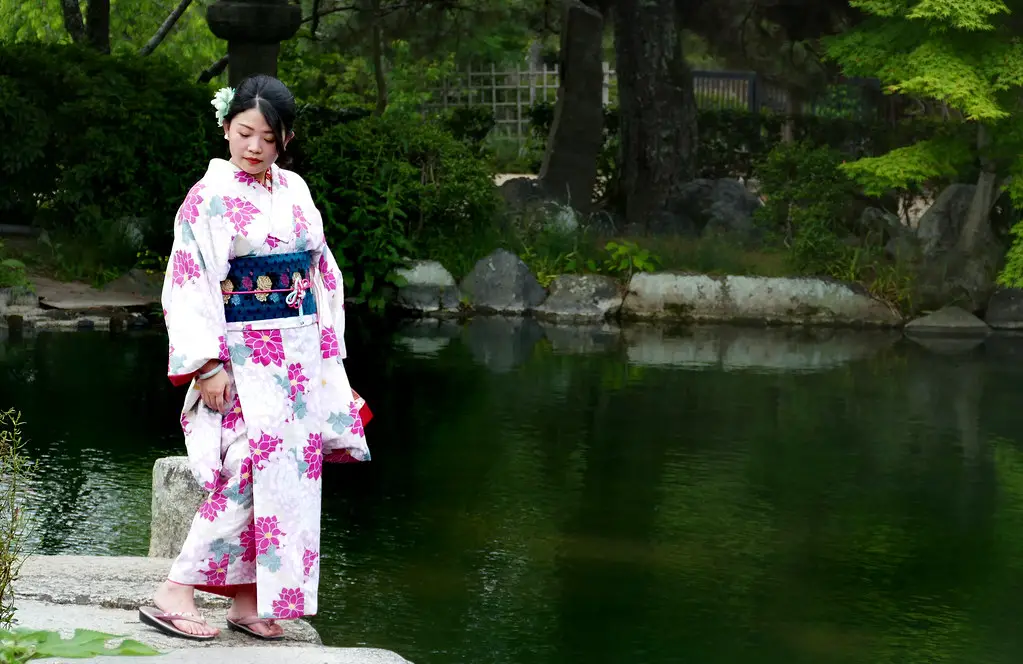Last Updated on May 30, 2022 by Janie Wilson
The Kimono is the traditional form of dress in Japan that has been used and incorporated into the fashion sense of a vast amount of people all over the world due to the beauty of these garments.
Both men and women can wear kimonos, which appear as full-length T-shaped robes with long sleeves and are kept closed with a decorative belt.
In length, they extend from the shoulders all the way down to the heels, coming in various types for specific occasions.
Everyday kimonos are constructed with a simpler format in comparison to more fanciful variations for formal occasions.
Kimonos are typically designed out of silk, and the wide belt that is tied across them is called an “obi.”
Inventor of the Kimono
The initial ancestor of the Kimono lived during the Heian period (794-1192) and wrote a version that was made of straight cuts of fabric that were sewn together to formulate a gratifying garment that could accommodate all sorts of body shapes.
This helped to make the Kimono very easy to wear and able to be an adaptable piece of clothing.
As the Kimono moved forward into the future, by the Edo period (1603-1868), it had continued to evolve and emerged as a unisex outer garment that was called Kosode.
Where Japanese Kimonos Originate From
Japanese Kimono (or gofuku ) was inspired by the garments that were commonly worn in China during the reign of the Wu dynasty.
The original Kimonos of Japan were influenced by the silk robe of Han Chinese clothing.
The Kimono was an old type of dress that was worn prior to the Chinese Qing Dynasty during the middle 1600s.
From the 8th to 11th century, a uniquely Japanese style of layering silk robes was established after taking inspiration from the Chinese Kimono.
What Japanese Kimono Symbolize
Believed to survive for a thousand years and to inhabit the land of immortals, the Kimono is recognized as a symbol of longevity and good fortune.
Particular motifs are used to indicate virtues or attributes of the wearer of the Kimono. These intricate differences can also relate to the season or a specific occasion, such as weddings and festivals, to bestow good fortune upon the wearer of the garment.
To people located in the Western hemisphere, the word “Kimono” is synonymous with their image of Japan.
Kimono Colors
The spring season brings out pale colors like light green; summer offers cool colors like lavender or dark blue, for autumn there are colors that represent the changing colors of the leaves on the trees, and winter is the season that gets represented by strong colors like red and black.
The beauty of the Kimono is further expressed with intricate embroideries on plain silk Kimono in both light and dark colors for casual use among women and men. When it is time for formal occasions, men wear a montsuki, which is a formal black silk Kimono that gets worn over a white under-kimono, and hakama, which are traditional Japanese trousers.
What Contributes to the Cost of Kimonos
The biggest reason for the relatively high cost of even the most casual Kimonos is that they cannot be mass-produced effectively.
The structure of the Kimono is so clever in its design that the majority of the edges and the seams aren’t able to be sewn by machine and are completed and also attached with blind stitches.
Another factor that contributes to the cost of the Kimono is the materials that it is designed with, along with the obi belt, which is usually silk brocade, silk crepes, linen, hemp, and satin weaves.
But contemporary Kimonos are available in easy-to-care-for affordable fabrics like rayon, cotton satin, cotton, polyester, and synthetic fibers.
How Kimonos Have Changed
When looking into how we know and understand Kimonos today, there has been quite an evolution of fabric, wearability, and design that has occurred.
Between the Nara period (710-794) until the Heian period (794-1192), the people of Japan generally wore one-piece garments or an ensemble consisting of separate upper garments with lower garments, such as trousers or skirts.
When it came to samurai, the hereditary military nobility of medieval and early-modern Japan, the Kimono was the daily form of dress, which in their case consisted of an inner layer and an outer layer that were normally constructed from silk.
The quality of the Kimono heavily depended on the Samurai’s status as well as their income. Beneath the Kimono that these warriors wore was usually a loincloth.
When it comes to the traditional Kimono, it is difficult to wear and quite pricey for the everyday person.
As far as more modern versions of the Kimono, they have been designed from rayon, polyester, and linen to have a style that is suitable for all seasons and to be able to move easily with them. These also have lesser layers and are more affordable than those made of silk.


